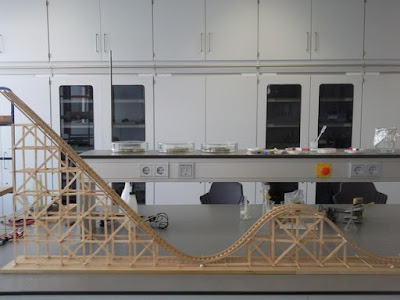17/10/15
Updated by Siming
Here is some further research into energy transformations in a
rollercoaster.
· The ride often begins as a chain and motor (or other mechanical
device) exerting a force on the
train of cars to lift the train to the top of a hill.
· Once the cars are lifted to the top of the hill, gravity takes over
and the remainder of the ride is an experience in energy transformation.
· At the top of the hill, the cars possess a large quantity of potential energy. The car's large
quantity of potential energy is due to the fact that they are elevated to a
large height above the ground.
· As the cars descend the first drop they lose much of this potential
energy in accord with their loss of height. The cars subsequently gain kinetic energy. The train of coaster
cars speeds up as they lose height. Thus, their original potential energy (due
to their large height) is transformed into kinetic energy (revealed by their
high speeds).
· As the ride continues, the train of cars are continuously losing and
gaining height. Each gain in height corresponds to the loss of speed as kinetic
energy (due to speed) is transformed into potential energy (due to height).
· Each loss in height
corresponds to a gain of speed as potential energy (due to height) is
transformed into kinetic energy (due to speed). The transformation of mechanical energy changes from the
form of potential to the form of kinetic and vice versa.
· On a well designed roller coaster loop, the riders will not be able
to sense when they are traveling upside down. This is done by making sure the
force that is exerted on the rider is at least equal to the weight of the
rider. Centripetal force applied
to the track depends on the velocity of the car. In order to apply enough
centripetal acceleration the roller coaster car has to either be traveling very
fast or the radius of the loop has to be made small.
· The underlying principle of all roller coasters
is the law of conservation of energy, which describes how energy can neither be
lost nor created; energy is only transferred from one form to another. The
first hill of a roller coaster is always the highest point of the roller
coaster because friction and drag immediately begin robbing the car of energy.
At the top of the first hill, a car's energy is almost entirely gravitational
potential energy.
· The typical roller coaster
works by gravity. There are no motors used to power it during the ride.
Starting from rest, it simply descends down a steep hill, and converts the
(stored) gravitational potential energy into kinetic energy, by gaining speed.
A small amount of the energy is lost due to friction, which is why it's
impossible for a roller coaster to return to its original height after the ride
is over.
· On a well designed roller coaster loop, the riders
will not be able to sense when they are traveling upside down. This is done by
making sure the force that is exerted on the rider is at least equal to the
weight of the rider. Centripetal force applied to the track depends
on the velocity of the car. In order to apply enough centripetal acceleration
the roller coaster car has to either be traveling very fast or the radius of
the loop has to be made small.
· The underlying principle of all roller coasters
is the law of conservation of energy, which describes how energy can neither be
lost nor created; energy is only transferred from one form to another. The
first hill of a roller coaster is always the highest point of the roller
coaster because friction and drag immediately begin robbing the car of energy.
At the top of the first hill, a car's energy is almost entirely gravitational
potential energy.
Bibliography:
Engineering K-PhD Program, Pratt School of Engineering, Duke University. Lesson: Physics of Roller
Coasters. Last modified:
November 4, 2015. https://www.teachengineering.org/view_lesson.php?url=collection/duk_/lessons/duk_rollercoaster_music_less/duk_rollercoaster_music_less.xml
Wayne, Tony. (1998) Coaster Physics: An Educational Guide to
Rollercoaster Design and Physics for Teachers and Students





